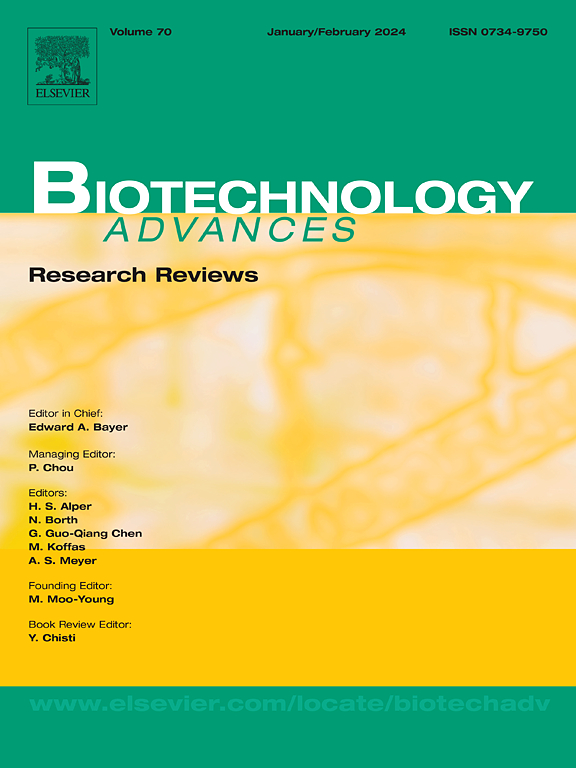Enzymatic depolymerization of lignin and electrocatalytic hydrodeoxygenation for the production of reduced aromatic compounds: A review and perspective
IF 12.5
1区 工程技术
Q1 BIOTECHNOLOGY & APPLIED MICROBIOLOGY
引用次数: 0
Abstract
The depletion of fossil resources and growing environmental concerns have intensified the search for sustainable alternatives for fuel and chemical production. Lignin, an abundant yet underutilized component of lignocellulosic biomass, presents significant potential as a renewable source of aromatic compounds. In this review and perspective, we highlight recent advancement in lignin valorization through enzymatic depolymerization using bacterial and fungal lignin degrading enzymes, and electrocatalytic hydrodeoxygenation (ECHDO). The review delves into the structure and inherent recalcitrance of lignin, alongside the mechanisms and efficiencies of various lignin-degrading enzymes, such as peroxidases and laccases, as reported in recent studies. It also provides a critical evaluation of the principles, benefits, and progress in ECHDO for upgrading lignin-derived compounds, with a focus on reactor design, catalyst systems, and energy efficiency. Key challenges and opportunities for advancing both processes are explored, along with future directions for their integration and optimization. While these technologies are currently being investigated separately, we provide a perspective for their potential integration by highlighting key challenges and opportunities for the development of an integrated bioelectrochemical platform for sustainable lignin valorization. By synthesizing current knowledge, this comprehensive review offers valuable insights for researchers and industry professionals striving to advance the sustainable utilization of lignin within biorefineries, contributing to the advancement of the circular bioeconomy.
木质素酶解聚合和电催化加氢脱氧制备还原性芳香族化合物的研究进展与展望
矿物资源的枯竭和环境问题的日益严重,促使人们加紧寻找燃料和化学品生产的可持续替代品。木质素是一种丰富但未充分利用的木质纤维素生物质成分,作为芳香族化合物的可再生来源具有巨大的潜力。在这篇综述和展望中,我们重点介绍了利用细菌和真菌木质素降解酶和电催化氢脱氧(ECHDO)通过酶解聚合降解木质素的最新进展。本文综述了木质素的结构和固有的顽固性,以及近年来报道的各种木质素降解酶(如过氧化物酶和漆酶)的机制和效率。它还对ecdo用于木质素衍生化合物升级的原理、效益和进展进行了关键评估,重点是反应器设计、催化剂系统和能源效率。探讨了推进这两个过程的关键挑战和机遇,以及它们集成和优化的未来方向。虽然这些技术目前正在单独研究,但我们通过强调开发可持续木质素增值的集成生物电化学平台的关键挑战和机遇,为它们的潜在整合提供了一个视角。通过对现有知识的综合,本综述为致力于推进生物炼制中木质素的可持续利用的研究人员和行业专业人士提供了有价值的见解,有助于促进循环生物经济的发展。
本文章由计算机程序翻译,如有差异,请以英文原文为准。
求助全文
约1分钟内获得全文
求助全文
来源期刊

Biotechnology advances
工程技术-生物工程与应用微生物
CiteScore
25.50
自引率
2.50%
发文量
167
审稿时长
37 days
期刊介绍:
Biotechnology Advances is a comprehensive review journal that covers all aspects of the multidisciplinary field of biotechnology. The journal focuses on biotechnology principles and their applications in various industries, agriculture, medicine, environmental concerns, and regulatory issues. It publishes authoritative articles that highlight current developments and future trends in the field of biotechnology. The journal invites submissions of manuscripts that are relevant and appropriate. It targets a wide audience, including scientists, engineers, students, instructors, researchers, practitioners, managers, governments, and other stakeholders in the field. Additionally, special issues are published based on selected presentations from recent relevant conferences in collaboration with the organizations hosting those conferences.
 求助内容:
求助内容: 应助结果提醒方式:
应助结果提醒方式:


